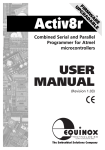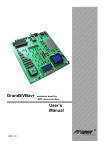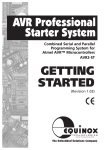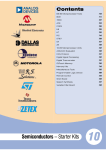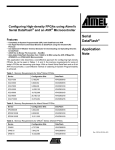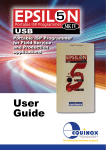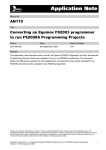Download - Farnell
Transcript
RE E A BL W DA RM A FI GR P U Serial Programming Systems for the Atmel 89S, AT90S (AVR) & ATmega microcontroller families USER GUIDE (Version 2.03) Micro-ISP Series IV User Manual V2.03 Copyright Information Equinox guarantees that its products will be free from defects of material and workmanship under normal use and service, and these products will perform to current specifications in accordance with, and subject to, the Company’s standard warranty which is detailed in Equinox’s Purchase Order Acknowledgment. or copied only in accordance with the terms of the agreement. It is against the law to copy the software on any medium except as specifically allowed in the license or non-disclosure agreement. The purchaser may make one copy of the software for backup purposes. No part of this manual may be reproduced or transmitted in any form or by any means, electronic, mechanical, including photocopying, recording, or information retrieval systems, for any purpose other than for the purchaser’s personal use, without written permission. Equinox reserves the right to change specifications detailed in this document without notice and does not represent a commitment on the part of the manufacturer. The software described in this document is furnished under license agreement or non-disclosure agreement and may be used © 1998 Copyright Equinox Technologies UK Limited. All rights reserved. AtmelTM and AVRTM are trademarks of the Atmel Corporation Microsoft, MS-DOS, WindowsTM and Windows 95TM Windows NT™ are registered trademarks of the Microsoft Corporation IBM, PC and PS/2 are registered trademarks of International Business Machines Corporation Every effort was made to ensure accuracy in this manual and to give appropriate credit to persons, companies and trademarks referenced herein. Disclaimer Please note about diagrams contained within this document: Whilst suggested circuits are offered in good faith, Equinox will not be liable in any way for any problems which might arise out of their use. i Micro-ISP Series IV User Manual V2.03 Electromagnetic Compatibility (EMC) Compliance The Micro-ISP Programmer is a CE Approved Product. It is designed only for use in a development environment only. This means that the user must ensure that there is no possibility of damage from electrostatic discharge (ESD). Since the devices and equipment to which this product is likely to be connected may well themselves be susceptible to ESD, this should not pose any difficulty. For example, if you are handling microcontrollers and EEPROMS etc. then you will already be used to appropriate precautions, such as the use of anti-static mats, wrist straps and so on. You should treat your Micro-ISP with the same care as you would these type of device. Always ensure that you are not yourself carrying a static charge before handling the product. Wearing an earthed anti-static wrist strap is recommended. Equinox have taken great care in designing this product to be compliant with the European EMC directive. When using the equipment be sure to follow the instructions provided. Although RF emissions are within prescribed limits, care should be taken if you are using the product near to sensitive apparatus. If you experience any difficulty please refer to Equinox technical support. ESD Points to remember ● Work in a static-free environment. ● Wear an earthed wrist strap when handling either the programmer and/or any programmable device. Please Note: This equipment is designed for use in a ‘Development Environment’ only and is NOT guaranteed to operate correctly in a ‘Production Environment’. Use of this product in a ‘Production Environment’ will invalidate your warranty. ii Micro-ISP Series IV User Manual V2.03 Technical Support It is often the case that users experience problems when installing or using a product for the first time. Due to the low-cost nature of this product, Equinox are unable to answer technical support questions about this product or its use by telephone. If you have a technical support problem, please consult the following list for help: 1 This manual 2 Troubleshooting Guide (see page 28) 3 On-line help Press <F1> for help at any time. The help system is context-sensitive. Simply press <F1> on any error message and the possible causes of the error should be listed. This help system is updated on a regular basis. Please see software update details for information on keeping up-to-date with software revisions. 4 Internet Web Site Equinox have setup an AVR™ microcontroller support page on our web site. This page is designed to provide up-to date information on all issues concerning both AVR™ microcontrollers and support tools. The microcontroller support page can be found at: www.equinox-tech.com/avr 5 E-mail Please e-mail any technical support questions about this product to: [email protected] Equinox will try our best to answer your questions about this product as quickly as possible. However, we can not promise an immediate reply. Please consult our web site for new software updates as the problem that you are enquiring about may have already been fixed in a new version. 6 Fax Please fax any technical support questions about this product to: +44 (0) 1204 535555 Equinox will try our best to answer your questions about this product as quickly as possible. However, we can not promise an immediate reply. Please consult our web site for new software updates as the problem that you are enquiring about may have already been fixed in a new version. iii Micro-ISP Series IV User Manual V2.03 Contacts Equinox Technologies UK Limited 3 Atlas House, St Georges Square, Bolton, England BL1 2HB Telephone Sales ....................... : +44 (0) 1204 529000 Fax ........................................... : +44 (0) 1204 535555 E-mail ...................................... : [email protected] Web site .................................. : www.equinox-tech.com For technical support on this product please e-mail us at: [email protected] Software Updates In line with our policy of continuous improvement, the ‘Meridian for Windows™’ software is updated on a regular basis. The firmware of the actual programmer is also periodically updated. If you would like to receive an automatic e-mail every time a new version is released, please make sure you have registered your system with Equinox and you have quoted your e-mail address. You may cancel this service at any time. The Meridian software updates can currently be downloaded from the following places: Internet : www.equinox-tech.com Select <software> this will take you to the software download page iv Micro-ISP Series IV User Manual V2.03 About AVR Microcontrollers Atmel manufacture a complete family of AVR and 89S microcontrollers each with differing FLASH, EEPROM, SRAM and number of I/O pins. Data sheets for these devices can be viewed and printed using the Acrobat pdf reader software supplied on the Atmel CD-ROM. As data sheets are often updated on a regular basis, it is recommended that you consult the Atmel web site for the latest information. A few sources of further information about Atmel AVR microcontrollers are listed below: Atmel web site : www.atmel.com Equinox web site : www.equinox-tech.com/avr If you have any silicon related technical support question about AVR and 89S microcontrollers which can not be answered by looking at the Atmel/Equinox web sites, please e-mail: AVR - [email protected] 89S - [email protected] with a detailed description of the problem. Important - Please note Equinox Technologies are unable to answer direct technical support questions concerning AVR microcontrollers. Please contact your local Atmel distributor or sales office if you require any further information. v Micro-ISP Series IV User Manual V2.03 Contents Introduction.........................................................................1 Device Support....................................................................2 System Specifications .........................................................3 Hardware Overview ...........................................................4 Hardware/Software Installation Overview ......................5 Meridian for Windows Overview......................................6 Hardware Installation Instructions ....................................7 Serial Port Selection............................................................8 Software Overview.............................................................9 Device Programming Guide .............................................11 In-System Programming Overview..................................18 ISP Header Pin Assignments ............................................19 ISP Cable Convertor ..........................................................20 Target System Requirements ...........................................21 Atmel AT89S/89LS - ISP Notes..........................................22 Atmel ATmega103/603 - ISP Notes ..................................24 Atmel AT90S/ATtiny - ISP Notes ......................................25 Upgrading the Programmer Firmware ............................26 Micro-ISP Compatible Target Systems.............................27 Troubleshooting Guide .....................................................28 Micro-ISP Series IV User Manual V2.03 Introduction The Micro-ISP is a state-of-the-art device programmer supporting the new range of In-System Programmable (ISP) microcontrollers from Atmel. These microcontrollers feature serially downloadable memory allowing both CODE and DATA (if device features EEPROM) areas to be updated in-system without physically removing the target device from the application board. The serial programming is based around the industry standard SPI protocol which is a 3-wire bus featuring two data lines and a clock line. MICRO-ISP DEVICE PROGRAMMER HIGHLIGHTS • State-of-the-art Device Programmer • Supports In-System Programming (ISP) of: • Atmel 89S microcontroller family • Atmel AVR(90S) microcontroller family • Atmel ATmega microcontroller family • Atmel ATtiny microcontroller family • Powerful Windows Interface Software Meridian compatible with Win3.1, 95, 98 & NT • Device Manufacturer Certification for The Micro-ISP programmer currently supports the Atmel 89S, AVR™(90S), ATmega and ATtiny microcontroller families as standard. many algorithms • Connects to spare PC Serial Port • Straightforward hardware/software installation The Micro-ISP programmer features extremely fast programming speeds due to the use of dedicated hardware to generate the SPI waveforms. • Supports programming of security lock bits • The programmer firmware is field upgradable allowing new devices and enhancements to be added in the future Please Note: FAST programming times due to: This programmer is designed for development use only. • Enhanced serial programming algorithms • SPI programming waveforms generated by dedicated hardware Two versions of the programmer are available: • Standard voltage : UISP-S4 (4.8-6.0V) • Low voltage : UISP-LV4 (3.3-6.0V) 1 Micro-ISP Series IV User Manual V2.03 Device Support ATMEL 89S FLASH Microcontroller Family AT89S8252 AT89S53 AT89LS8252 AT89LS53 Atmel AVR ‘Classic’ Microcontroller Family AT90S1200 AT90S1200A (same as AT90S1200 with RCEN Enabled) AT90S2313 AT90S2323 AT90S2333 AT90S2343 AT90S4414 AT90S4434 AT90S8515 AT90S8535 AT90LS2333 AT90LS4433 AT90LS4434 AT90LS8535 Atmel ATmega FLASH Microcontroller Family ATmega103 ATmega603 ATmega103L ATmega603L Atmel Tiny FLASH Microcontroller Family ATtiny22 Please note: Only ATtiny devices which feature a ‘Low Voltage Serial Programming Mode’ are supported. Caution. Make sure you do not exceed the maximum voltage of the target device. 2 Micro-ISP Series IV User Manual V2.03 System Specifications Minimum System Contents The Micro-ISP Series IV programmer is available as either a +5V or low voltage version. The minimum system contents for both versions are as follows: • Micro-ISP Serial Download Programmer • Windows Driver Software • ISP Cable convertor • PC Serial extension cable set • Atmel CD-ROM Micro-ISP Serial Programmer Specifications Programmer Size Shipped Weight PC Connection Programming Cable Header Power Supply : : : : : : 55 x 53 x 16mm Approx 0.10kg Serial Port 25-pin female D Connector Length 300mm 10-way IDC 0.1” pitch bump polarised Requires power from target system or external power supply. Series IV Vcc. 4.8 - 6.0V - Is (supply) approx 50mA when programming - Is (supply) approx 27mA in standby Series IV LV Vcc. 3.3 - 6.0V - Is (supply) approx 36mA when programming @ 3.3V - Is (supply) approx 22mA in standby @ 3.3V - Is (supply) approx 70mA when programming @ 5V - Is (supply) approx 37mA in standby @ 5V Minimum PC requirements The minimum hardware and software requirements to ensure that the programmer operates correctly are as follows: • 100% IBM compatible 386+ • Windows 3.1 or higher • Minimum 4MB RAM • Minimum 1MB free hard disk space • Spare PC serial port 3 Micro-ISP Series IV User Manual V2.03 Hardware Overview Red stripe (denotes pin 1) 5 6 2 4 1 Key 1 2 3 4 5 6 Micro-ISP Programmer Serial Programming Cable (length approx 300mm) 10-way IDC Header Plug 25 pin female D-Connector (plugs into PC serial port) Power LED Active LED 4 3 Micro-ISP Series IV User Manual V2.03 Hardware/Software Installation Overview The Hardware/Software Overview for the installation process of the Micro-ISP programmer is detailed diagrammatically below. Please refer to the following pages for a more detailed explanation. Perform Software Installation Perform Hardware Installation Select the correct serial port <OPTIONS> <SELECT PORT> Try selecting another Com port Installation Trouble Shooting Guide (See on-line help) <TEST> PORT FAIL PASS Programmer should now be “ON LINE” 5 Micro-ISP Series IV User Manual V2.03 Meridian for Windows Overview The Micro-ISP programmer is supplied with 'Meridian for Windows' PC driver software. This software is supplied on one 3.5" floppy disk or can be downloaded from the Equinox web site. To Install 'Meridian for Windows' software: • Boot the PC into Windows environment (Win 3.1, Win 95 or NT) • Insert 'Meridian for Windows' disk into floppy disk drive (A: / B:) Meridian Programmer Interface Software • Select the 'Run...' command from the 'File' menu in the Program Manager • Powerful Windows Programmer Interface Software compatible with Windows 3.11™ Windows 95™, Windows 98™ & Windows NT™ • Select 'Browse' and navigate to the floppy drive (A: / B:) • Select 'meridian.exe' • Select the 'OK' button • Device: Check, Signature, Erase, Blank Check, Read, Program, Verify, Special Options and Security The software installation program should now display an introductory screen. Please follow the on-screen prompts in order to complete the software installation process. • Supports programming of microcontroller fuse bits • Programmable RESET polarity On completion, the installation program will install the 'Meridian' icon within a new program group called 'Equinox'. • Powerful RESET Timing utility allows most RESET circuits to be accommodated including C/R, External Watchdog and 3-pin CPU supervisor devices To launch the software, simply double-click on the 'Meridian' icon. • Powerful Auto-Program Utility • Fast programming times due to dedicated SPI Hardware • Powerful Multiple File Loading Utility • Supports Bin & HEX file formats • Comprehensive context-sensitive on-line help system The Meridian software was introduced by Equinox to support the following range of programmers: Micro-ISP Series III Micro-ISP Series III LV Micro-ISP Series IV Micro-ISP Series IV LV Activ8r (Atmel 8051 version) Activ8r (Atmel AVR version) 6 Micro-ISP Series IV User Manual V2.03 Hardware Installation Instructions Overview The Micro-ISP programmer connects to any spare PC serial (COM) port. If you only have one serial port and this is in use for e.g. a modem, it may be possible to add another serial port to your machine by inserting a new I/O card. For further hardware installation help, please refer to the: Installation Troubleshooting Guide Warning ! To avoid catastrophic damage to PC, programmer or target system: • Ensure that both your target system and PC are connected to a common earth point. • Make sure that all interconnections are made before applying power to PC and target system. • If you are using a laptop or PC which is not connected to mains earth, it is recommended that you make a hard-wired connection from the COM port D-connector shell and the target system to a common earth point. • Avoid plugging and unplugging ISP connector while either the PC or target system is powered up. • Please ensure that any devices connected to the user target system are also properly grounded to the same common earth point. • Please see Diagram Micro-ISP PC 1 User Target System External Devices 2 1 Earth connection to PC 2 Target system earth 3 Earth from external device 3 Common earthing point Any damage caused to the programmer through inadequate earthing is not covered under warranty 1 Connect the serial cable provided to a spare COM port on the PC using the 9-25 way adaptor if necessary. 2 Connect the Micro-ISP to the other end of the serial cable. 3 Connect IDC plug at the end of the serial programming cable into the 10-way IDC header on the user target board (not supplied). 4 Apply power to the target board. Please ensure that the target system is powered up. The programmer will not operate unless a Vcc in the specified range is applied on pin 1 of the IDC connector. (The Micro-ISP draws its power from the target) 7 Micro-ISP Series IV User Manual V2.03 Serial Port Selection (Select Port) The Micro-ISP programmer plugs into a spare serial (com) port of any IBM compatible PC including the majority of laptop machines. Communications Test Pass The programmer has been detected OK by the Meridian software. If you now <Cancel> out of the <Test Port> dialogue box, the words ‘ON LINE’ should now be displayed at the bottom right of the Micro-ISP Window. To select the Correct Serial Port i. From the menu bar select <Options> <Select Port> Installation is complete and the programmer should now be ready to-use. The available COM ports on your computer are now displayed. Communications Test Fail ii. Select the COM port to which the programmer is connected The programmer was not detected on the COM port selected. Please check that the correct COM port was selected, and if not, repeat the <Select Port> < Test> operation. ii. Select a baud rate e.g. 56K iii. Select <Test> A programmer communications test is now performed. If your PC is not fast enough to operate at the default highest communication speed, it may be necessary to slow the communication down. This can be achieved by choosing a slower baud rate from the list provided. This tests both the programmer, cable and PC serial port. Test Programmer Checking Port Checking Communication If the programmer is still not detected, please refer to the Installation Troubleshooting Guide located in the “On-Line” help. : Pass : Checking Communication : Cancel Select Communication Port Port : COM2 Test Speed : 56000 OK Cancel 8 Micro-ISP Series IV User Manual V2.03 Software Overview The Meridian for Windows™ software features many powerful functions which can be activated by simply clicking a single icon. Other utilities and commands are available by selecting the relevant menu option. For further information about the Meridian for Windows™ software , please refer to the 'On-line Help System' supplied with the software (F1). The most commonly used functions for which an icon exits are listed below. LOAD FILE TO BUFFER (F9 or Ctrl + L) Allows you to select a file or multiple files and load the file(s) into the programmer buffer area(s). Currently supports Intel Hex and Binary file formats as standard. SAVE TO DISK (Ctrl + S) Allows you to save the contents of the buffer(s) to a file. Currently supports Intel Hex and Binary file formats as standard. BLANK CHECK Checks if the currently selected device is blank. i.e. All locations = FFh VERIFY DEVICE Compares the contents of the buffer area(s) with the contents of the currently selected device. WRITE DEVICE Writes with contents of the buffer into the device Note: This operation does NOT perform an electronic erase before writing data. 9 Micro-ISP Series IV User Manual V2.03 Software Overview continued DEVICE READ Reads the contents of the currently selected device into the programmer buffer area(s). ERASE DEVICE Performs an ELECTRONIC erase on the currently selected device. DEVICE AUTO-PROGRAM Performs a complete programming cycle including Signature Check, Erase, Blank check, Write, Special Options, Security etc. SECURITY Allows you to READ/WRITE the security lock bits of any device which supports this feature. 10 Micro-ISP Series IV User Manual V2.03 Device Programming Guide The Micro-ISP Programmer is now ready to program a target device. In the following example we have chosen to program an Atmel AT90S1200 microcontroller located on the user target system. 1 From Meridian select <Options> <Create Library Info> This operation interrogates the target programmer and generates a ‘notepad’ document which details information about your programmer and generates a list of devices supported by the programmer. From the list you can see which ‘TARGET ISP’ devices can be programmed with the Micro-ISP. i.e. only devices listed as ‘yes’ or LNR’ are supported. Select Chose <Select>, Chose <AT90S>, Chose <Target (ISP)> and finally click on the target device, in our example <AT90S1200ISP>. Information ▲ 2 To select the target device click on the <Device menu> Orientation Check Signature 3 From the< Device menu> select<Information> Blank Check This will give you a description of the target device. ATmega The write time of the FLASH and EEPROM varies with target voltage. Meridian defaults to the correct settings for +5V. If your target system is powered from less than 5V it may be necessary to change the write time. ATtiny AT90S AT89S/89LS ZIF Socket Target (ISP) Enter the recommended ‘Write Time’ - for the selected device from the tables overleaf Enter the required ‘EE Write Time’. This time is automatically updated to be the same as the ‘FLASH write time’ for all devices except the ATmega family. Click <OK>. AT90S1200 ISP AT90S1200A ISP AT90S2313 ISP AT90S4414 ISP AT90S8515 ISP AT90S2323 ISP 11 ▲ ▲ To alter the write time settings select <Options> <SPI Program Options> AT89C ▲ ▲ ▲ ▲ ▲ 4 Setting of target write times (LV programmers only) Micro-ISP Series IV User Manual V2.03 Device Programming Guide continued Overview The following tables detail the result of testing the programming of various target microcontrollers in the laboratory. These timings and settings are meant for guidance only. E&OE. Results may differ depending on microcontroller batch, power supply, target system etc. Definitions: Voltage - Supply voltage to programmer and target device Flash Write Time - Minimum time to program a byte or page (ATmega only) of the target microcontroller FLASH area EEPROM Write time - Minimum time to program a byte of the target microcontroller EEPROM area Fspi - Frequency of SPI signal from programmer to target device Fosc - Frequency of target microcontroller oscillator Code time - Time taken to program the target device CODE area with random data Data time - Time taken to program the target device DATA area with random data All measurements were taken with the following equipment: Meridian V2.12 PC - DX2-50 Micro-ISP Series IV LV Windows 95 Communication speed: 56,000 baud 12 Micro-ISP Series IV User Manual V2.03 Device Programming Guide continued AT89S/89LS - Timing Characteristics Voltage (V) Flash Write Time (ms) EEPROM Write Time (ms) FSPI (KHz) FOSC (MHz) Code time (secs) Data time (secs) 3.0 3.0 3.3 3.3 3.5 3.5 4.0 4.0 4.5 4.5 5.0 5.0 5.5 5.5 6.0 6.0 5 5 5 5 5 5 4 4 4 4 2 3 1 1 1 1 5 5 5 5 5 5 4 4 4 4 2 3 1 1 1 1 15 15 50 50 100 50 50 100 100 50 100 50 100 50 100 50 12 4 12 4 12 4 12 4 12 4 12 4 12 4 12 4 78.5 78.5 56.2 56.2 54.3 56.2 47.4 45.1 45.1 47.4 29.0 38.1 19.8 23.1 19.8 23.1 12.0 12.0 14.0 14.0 13.5 14.0 12.0 11.5 11.5 12.0 7.5 9.5 5.0 6.0 5.0 6.0 For the AT89S/89LS family it is necessary to change both the ‘FLASH/EEPROM write times’ and the ‘SPI Frequency’ depending on target voltage and oscillator frequency. The table shows results for 4MHz and 12MHz. The AT89S device should program correctly at >4.0V with a target frequency of 4MHz to 24MHz. The AT89LS should program correctly at 3.0V to 6.0V as long as the target oscillator frequency is 12MHz or below. 13 Micro-ISP Series IV User Manual V2.03 Device Programming Guide continued Atmel AVR ‘Classic’ Microcontroller Family - Timing Characteristics Voltage (V) Flash Write Time (ms) EEPROM Write Time (ms) FSPI (KHZ) FOSC (MHz) Code time (secs) Data time (secs) 3.0 3.3 3.5 4.0 4.5 5.0 5.5 6.0 6 5 4 4 3 3 2 2 6 5 4 4 3 3 2 2 70 70 70 70 70 70 70 70 3.6864 3.6864 3.6864 3.6864 3.6864 8 8 8 65.0 56.0 48.0 48.0 39.0 39.0 30.0 30.0 4.0 3.5 3.0 3.0 2.5 2.5 1.9 1.9 • For the Classic AVR and ATtiny family, it is only necessary to alter the ‘FLASH/EEPROM write times’ depending on the target voltage. • Erasing of the target device is not guaranteed below 3.4V. This can cause programming errors as random locations may not have erased correctly. This is a silicon limitation for which there is currently no workaround. ATMega103/103L - Timing Characteristics Voltage (V) Flash Write Time (ms) EEPROM Write Time (ms) FSPI (KHZ) FOSC (MHz) Code time (secs) Data time (secs) 3.8 4.0 4.5 5.0 45 35 30 22 7 7 5 4 70 70 70 70 3.6864 3.6864 3.6864 3.6864 231.1 226.1 223.4 219.2 38 38 30 25 • For the ATmega family, it is necessary to alter the ‘FLASH write time’ on a per page (256 bytes) basis and the ‘EEPROM Write time’ on a byte-by-byte basis depending on the target voltage. • Erasing of the target device is not guaranteed below 3.4V. This can cause programming errors as random locations may not have erased correctly. This is a silicon limitation for which there is currently no workaround. • Correct programming of ATmega103L devices at voltages less than 3.8V with revision ‘K’ silicon was found to be unreliable. • The Micro-ISP Series IV LV’ programmer is slower at programming the ATmega103 than the +5V programmer at a given voltage. 14 Micro-ISP Series IV User Manual V2.03 Device Programming Guide continued 5 Setting of the ‘SPI frequency’ The setting of the ‘SPI frequency’ also varies with the target voltage. It may be necessary to change the ‘SPI frequency’ (Fspi). To alter the ‘SPI frequency’ select <Options><ISP Settings> Enter the recommended ‘SPI frequency’ see the ‘Timing Characteristic Tables’. 5 6 7 These tables show the fastest programming speeds achieved at Equinox Technologies on two different target devices. The optimum timings for these and other devices will vary. It may be necessary to experiment with differing settings to achieve the fastest times. 6 Setting the ‘Target Reset Polarity’ Meridian automatically sets the polarity of the programmer RESET signal (PROG_RESET) to be the correct default polarity for the target device being programmed. Some users may wish to change the ‘Target Reset Polarity’ if the RESET circuit on the target system is inverted for some reason. 7 Setting the ‘ISP RESET Timing’ parameters The programmer outputs a sequence of pulses on the PROG_RESET, PROG_MOSI, PROG_MISO, PROG_SCK1 and PROG_LED signal lines in order to force the target device into ‘Serial Programming Mode’. The programmer effectively runs a statemachine where the programmer I/O lines are set to certain states for periods of time as specified by the ‘T1....T6’ timing parameters. The default settings are for a generic Capacitor/Resistor RESET circuit and a target system operating at +5V. For Atmel AVR, ATmega and ATtiny devices, the default timing parameters should operate correctly for most target systems without any changes. However, the Atmel 89S microcontroller family suffers from many problems in entering ‘Serial Programming Mode’ correctly if the RESET circuit is changed from a C/R network. The choice of the correct RESET circuit and relevant settings for the ‘T1....T6’ timing parameters is beyond the scope of this manual. Further information is available in separate application notes to be found on the Equinox Web Site. 15 Micro-ISP Series IV User Manual V2.03 Device Programming Guide continued 8 Loading user code/data to the buffer areas To program the target system the buffer must first be loaded with the user code/data. • Select <File> <Load to Buffer...> The ‘Load to Buffer’ dialogue is now displayed. • To load a file into the CODE area, click <Browse> in the code section. Select the required file, click <Load> This loads the same file into both the code and data areas by default. • To load a different file into the DATA area , click<Browse> in the data section. Select the required file, click <Load> The buffer(s) should now be loaded. Click <OK> to quite out of the ‘Load dialogue box’. 9. Using <Auto-Program> to program a target device The most straightforward method of programming a target device is to select <Device><Auto-Program> or click the <Auto-Program> icon. An ‘Auto-Program’ performs the following actions: • • • • • • • • • • Pre-programming State machine operation Check Signature (except 89S/89LS - no signature) Chip Erase Blank Check (CODE/DATA areas) Write CODE area Verify Pass 2 - CODE area Write DATA area Verify Pass 2 - DATA area Write Special Options (Fuse bits etc.) Write Security The auto-program operation is setup by selecting <Device><Auto-program Options>. 16 Micro-ISP Series IV User Manual V2.03 Device Programming Guide continued 10. Using the <Device> commands individually It is possible to fire off any programmer command individually from the <Device> menu. Please note: i. The programmer will, by default, perform a ‘Pre-programming State machine operation’ and a ‘Check Signature’ for each operation selected. The ‘Check Signature’ can be disabled using a tick box. ii. The <Device><Write> operation does not perform a ‘Chip Erase’ operation. If there is already non-FF data in the target device then the ‘Write’ operation will fail. A manual <Device><Erase> is required to erase the device. iii. The <Device><Special Options> operation allows the user to read the current values of the fuse bits of the target device (if the device supports this). New values can also be written to the target device. Further sources of information: Equinox application notes: AN100 AN101 AN102 AN103 - ISP ISP ISP ISP Design Design Design Design Notes Notes Notes Notes for for for for the the the the Atmel Atmel Atmel Atmel AT90S (Classic AVR) Microcontroller Family ATmega Microcontroller Family ATtiny (AVR) Microcontroller Family AT89S/AT89LS Microcontroller Family 17 Micro-ISP Series IV User Manual V2.03 In-System Programming Overview It is possible to In-System Program (ISP) members of the Atmel AVR microcontroller by utilising a serial programming algorithm based around the popular SPI 3-wire bus protocol. The Micro-ISP programmer implements ISP of these devices by generating the necessary SPI programming waveforms under control of PC software. In order to place the target device into programming mode, it is necessary to assert the RESET pin of the target microcontroller. SPI Master/Slave definitions The Micro-ISP programmer operates on the principle that during any programming operation the programmer is the SPI Master and the target device to be programmed is the SPI Slave. Micro-ISP Programmer ............. SPI Bus Master Target ISP Microcontroller(s) ... SPI Bus Slave(s) This status is only the case during ISP. The target microcontroller can be a master or slave during program execution (i.e. when it is programming code). The programmer tri-states off the SPI bus when not programming. Typical Hardware Configuration for In-System Programming (ISP) Mode PC RST MOSI MISO SCK MICRO-ISP Programmer PC Ground Target System Target Ground Common earth point 18 Micro-ISP Series IV User Manual V2.03 ISP Header (Target System) Micro-ISP - Target System Connection Details 10-Way IDC Header Top Pin View PROG_Vcc The programmer 10-way ribbon cable supplied is terminated with a standard 10-way 0.1" pitch IDC plug. This is designed to mate with the complimentary male 10-way IDC header on the target system. The pin-out of the header is shown opposite: PROG_SCK2 PROG_LED PROG_GND PROG_GND 1 2 3 4 5 6 7 8 9 10 PROG_SS PROG_MOSI PROG_MISO PROG_SCK1 PROG_RESET Note: This is the view of the connector fitted to the target (e.g. Evalu8r) board, as seen from above (the component side). ISP Pin Assignments Y Pin Programmer Name I/O Micro-ISP Pin Description ATmega MCU Connect 1 2 3 4 5 6 7 8 9 10 PROG_Vcc PROG_SS PROG_SCK2 PROG_MOSI PROG_LED PROG_MISO PROG_GND PROG_SCK1 PROG_GND PROG_RESET O O O O I O O Programmer Power (+Vcc) SPI - Slave Select SPI - Serial Clock 2 SPI - Master Output Program LED SPI - Master Input Programmer GND connection SPI - Serial Clock 1 Programmer GND connection Target RESET control pin x x x PD1/RXD x PD0/TXD x x x x Vcc x N/C MOSI x MISO GND SCK GND RST Y x x Y x Y Y Y Y Y = This connection must be made N/C = No Connect x = Optional MCU = AT90S/89S/89LS/ATtiny Connector recommendations The IDC connector supplied with the Micro-ISP programmer is ‘bump’ polarised so that it can not be inserted the wrong way around in a polarised socket. If the connector used on the target system is not polarised, it is advised that measures are taken to prevent the connector being plugged in the wrong way around. This could be achieved by removing pin 9 (a second ground) from the target header and placing a blanking piece of plastic in pin 9 of the cable header. 19 Micro-ISP Series IV User Manual V2.03 ISP Cable Convertor This cable allows the Equinox ‘Micro-ISP’ and ‘Activ8r’ programmers to interface to existing customer target boards which feature the Atmel 10-way or 6-way ISP header. The convertor also makes it possible for users of Atmel’s STK200 and STK300 systems to upgrade to the Equinox solution whilst retaining the original evaluation board. The ‘ISP Cable Convertor’ is now supplied with all new Equinox ISP systems as standard. ISP Cable Convertor User target system with Atmel 10-pin convertor e.g. STK200/300 Micro-ISP Programmer * Target System Not Provided Equinox ISP Pin 1 2 3 4 5 6 7 and 9 8 10 Atmel ISP Pin 2 No connection No connection 1 3 9 4, 6, 8 and 10 7 5 Equinox ISP Pin 1 2 3 4 5 6 7 and 9 8 10 Atmel ISP Pin 2 No connection No connection 4 No connection 1 6 3 5 Pin Mapping for the Equinox 10-way to the Atmel 10-way ISP Function Vcc /SS SCK2 MOSI /PROG MISO GND SCK /RESET Equinox 10-way N/C Atmel 10-way N/C 1 2 3 4 1 3 4 5 6 5 6 7 8 7 8 9 10 9 10 2 (Cable fitted as standard) Pin Mapping for the Equinox 10-way to the Atmel 6-way ISP Function Vcc /SS SCK2 MOSI /PROG MISO GND SCK /RESET Equinox 10-way 1 2 N/C 3 4 N/C 5 6 7 8 9 10 Atmel 6-way N/C (Cable not fitted as standard) 20 1 2 3 4 5 6 Micro-ISP Series IV User Manual V2.03 Target System Requirements The following target system requirements must be met for the Micro-ISP programmer to operate correctly : • Target oscillator The target microcontroller oscillator must be running between certain prescribed frequencies. These can be found in the relevant microcontroller data sheets. The oscillator could be an external crystal/resonator or could be an internal RC oscillator (e.g AT90S1200 and AT90S2343). • Power The Micro-ISP requires a regulated DC supply to operate. This supply can be taken either from the user target system or an external power supply unit (PSU). The programmer should operate correctly between the specified operating voltage limits (see hardware specifications). • RESET circuit The serial programming mode of the 89S and AVR family devices is initiated by asserting the RESET pin in the correct sense for a certain period of time. The programmer must, therefore, be able to assert the RESET pin on the user target microcontroller. External control of the RESET pin can be implemented in a number of different ways. Family Reset Polarity 89S Active High AVR (90S) Active Low ATmega Active Low ATtiny Active Low • SPI Enable Fuse The SPI Enable Fuse (SPIEN) must be ENABLED in the target microcontroller device for ISP programming to work. The SPIEN fuse can only be programmed in parallel programming mode with the device in the ZIF socket. All Atmel microcontrollers are supplied from the factory with the SPIEN fuse enabled as default. 21 Micro-ISP Series IV User Manual V2.03 Atmel AT89S/89LS - ISP Notes 1. RESET circuit PROG-RESET R2 Vcc PROG-VCC C4 C6 R1 U1 Vcc 1 Active High RESET Circuit EA RESET USER I/O P3 8 P3.0-P3.7 P2 8 P2.0-P2.7 P1 5 P1.0-P1.4 P0 8 2 LED1 J1 3 ATMEL AT89SXXXX Microcontroller Interrupt Pin SCK MOSI P0.0-P0.7 MISO PROG-ACTIVE P1.7 R3 P1.6 R4 P1.5 R5 PROG-SCK1 PROG-MOSI PROG-MISO XTAL1 XT1 XTAL2 GND C1 C2 PROG-GROUND USER INPUT USER INPUT P1.5 P1.6 P1.7 2. SCK connection USER-OUTPUT This should be an ‘Active HIGH’ RESET circuit. The 89S/89LS devices suffer from many problem in correctly entering ‘Serial Programming Mode. The programmer must output a number of pulses on the RESET pin which synchronise the target device. If a C/R network is used (C=10µF, R=10K), the default timings parameters ‘T1...T6’ should work correctly. However, if a RESET ‘Supervisor Device’ is used, the timings ‘T1...T6’ must be altered so that the pulse train is not filtered out by the RESET circuit. This is an output from the programmer and an input to the target device during programming. It is recommended that this pin is only used as an input on the user target circuit. The Atmel 89S/89LS device may fail to re-program if the target firmware asserts the SCK pin LOW within 700ms of coming out of RESET. 3. Protection resistors It is good EMC design practice to place some limiting resistance on each processor I/O line to protect against damage from transients. i.e. R2, R3, R4, R5. A very low value of e.g. 10 ohms is recommended. Further protection can be afforded by using ferrites instead of resistors. The ATmega devices are very sensitive to the voltage slew rate, so use of any component which slews the edges of the programming signals may cause unreliable programming. 22 Micro-ISP Series IV User Manual V2.03 Atmel AT89S/89LS - ISP Notes continued 4. SCK Noise filtering If noise spikes on the SCK pin are found to be a problem, a resistor i.e. R6 may be inserted between the SCK pin and ground. 5. Active LED An LED may be placed on the user target system to indicate when the programmer is active. The value of R7 should be chosen to suit the target supply voltage. Warning ! To avoid lock-up of the target device: - Avoid writing a ZERO to the SCK pin within 700ms of coming out of RESET. - Do not use the SCK pin as an output in your own target system. If the target device will not re-program, connect the EA pin to ground by moving J1 to position 2-3 and then try to re-program. Remove any writes to the SCK pin within your software! Further sources of information: AN103 - ISP Design Notes for the Atmel AT89S/89LS Microcontroller Family 23 Micro-ISP Series IV User Manual V2.03 ATmega103/603 - ISP Notes 1. RESET circuit This should be an ‘Active LOW’ RESET circuit. To prevent inevitable EEPROM corruption, an electronic brownout circuit is recommended such as a ‘RESET Supervisor’ device available from Dallas Semiconductor, Maxim, Seiko etc. PROG_ACTIVE 1 2 3 2. PEN The programmer does not support the ‘PEN’ method of entering RESET. The PEN pin should therefore be tied high. 3. MOSI/MISO connections The Atmega microcontrollers differ from other AVR/89S device in that the ISP programming is performed via the UART pins ‘PD1/RXD’ and ‘PD0/TXD’ pins instead of MOSI and MISO. This connection system can lead to driver contention problems with the ‘PROG-MOSI’ line and the output driver of an RS-232 Transceiver chip. Basically, if the ‘RS-232-RXD’ line is asserted, the programmer may not be able to assert the ‘PROG_MOSI’ pin. Possible workarounds include placing a resistor i.e. R5 in the path from the RS-232 transceiver to the RXD pin of the microcontroller or using a jumper i.e. J1 which the user must manually move before attempting to program the device. 4. Protection resistors It is good EMC design practice to place some limiting resistance on each processor I/O line to protect against damage from transients. i.e. R1, R3, R4, R5. A very low value of e.g. 10 ohms is recommended. Further protection can be afforded by using ferrites instead of resistors. The ATmega devices are very sensitive to the voltage slew rate, so use of any component which slews the edges of the programming signals may cause unreliable programming. 5. SCK Noise filtering If noise spikes on the SCK pin are found to be a problem, a resistor i.e. R6 may be inserted between the SCK pin and ground. 6. Active LED An LED may be placed on the user target system to indicate when the programmer is active. The value of R7 should be chosen to suit the target supply voltage. Further sources of information: AN100 - ISP Design Notes for the Atmel ATmega Microcontroller Family 24 Micro-ISP Series IV User Manual V2.03 Atmel AT90S/ATtiny - ISP Notes 1. RESET circuit PROG-RESET This should be an ‘Active LOW’ RESET circuit. To prevent inevitable EEPROM corruption, an electronic brownout circuit is recommended such as a ‘RESET Supervisor’ device available from Dallas Semiconductor, Maxim, Seiko etc. PROG-VCC C4 C6 R1 U1 Vcc Active LOW RESET Circuit LED1 RESET ATMEL AT90SXXXX Microcontroller USER I/O 2. SCK connection P3 8 PD.0-PD.7 P2 8 PC.0-PC.7 P1 5 PB.0-PB.4 P0 8 Interrupt Pin SCK MOSI PA.0-PA.7 MISO PROG-ACTIVE PB.7 R3 PB.6 R4 PB.5 R5 PROG-SCK1 PROG-MOSI PROG-MISO XTAL1 XT1 XTAL2 GND C1 C2 PROG-GROUND USER-OUTPUT USER INPUT USER INPUT PB.5 PB.6 PB.7 This is an output from the programmer and an input to the target device during programming. It is recommended that this pin is only used as an input on the user target circuit. However, it should still be possible to program the device even if the pin is set to an output by user firmware. R2 Vcc 3. Protection resistors It is good EMC design practice to place some limiting resistance on each processor I/O line to protect against damage from transients. i.e. R2, R3, R4, R5. A very low value of e.g. 10 ohms is recommended. Further protection can be afforded by using ferrites instead of resistors. The ATmega devices are very sensitive to the voltage slew rate, so use of any component which slews the edges of the programming signals may cause unreliable programming. 4. SCK Noise filtering If noise spikes on the SCK pin are found to be a problem, a resistor i.e. R6 may be inserted between the SCK pin and ground. 5. Active LED An LED may be placed on the user target system to indicate when the programmer is active. The value of R7 should be chosen to suit the target supply voltage. Further sources of information: AN102 - ISP Design Notes for the Atmel ATtiny (AVR) Microcontroller Family 25 Micro-ISP Series IV User Manual V2.03 Upgrading the programmer firmware This programmer features upgradable firmware technology which allows the actual control code within the programmer to be updated in the field. Upgrading the programmer firmware allows new features, new device algorithms and bug corrections to be added to the product in the future by means of a straightforward Windows reprogramming utility, without having to return the product to Equinox. All new programmers are shipped with the latest firmware from Equinox, but if your system has been purchased from a distributor and has been in stock for a long period of time, it may be that the firmware version is out-of-date. How do I check what version of firmware my programmer is running? i. Make sure the programmer is plugged into a spare COM port and is powered up ii. Launch the Meridian software -> The software should display “On Line” iii. Select <Options><Programmer Info> -> The firmware revision and date of loading are displayed. iv. Alternatively, select <Options><Create Library Info> and a text file is created containing all the programmer settings How do I update the programmer firmware? If the firmware version of your programmer is older than that on the Equinox Web Site, please download the new files from the ‘Software Updates’ page. It is important that you download both the latest ‘meridian.exe’ and ‘configit.exe’ programs. If you follow the instructions supplied with the ‘configit.exe’ program, the whole process should take less than 2 minutes. What do I do if there any problems? If the firmware update fails for any reason, please check the instructions supplied with ‘configit.exe’ in the first instance. If the problem persists or he program reports that a code is needed from Equinox, please e-mail or fax the full details below to Equinox, and we will attempt to get you up and running as quickly as we can. Details required: Name, Company name, telephone number, fax number, e-mail, place of purchase, programmer serial number (usually printed on a label on the programmer) and any update code you are prompted to send. Please note: It is possible that the firmware upgrade process may fail and there might be a delay in receiving license codes back from Equinox. PLEASE DO NOT attempt to upgrade your firmware if your immediate design process depends on it! 26 Micro-ISP Series IV User Manual V2.03 Micro-ISP Compatible Target Systems The products listed below have been specially designed to interface with the Micro-ISP programmer • AVR/89S ISP Socket Stealer Modules Plugs into most 40-pin DIL generic AVR/89S microcontroller sockets. Ideal for AVR/89S ISP evaluation and small production runs where target board redesign would be more expensive or where time constraints have been imposed. • Microcontroller Personality Module This dedicated Microcontroller Personality module supports most 8-pin, 20-pin and 40-pin Atmel 8051 & AVR microcontrollers. The module features an ISP header which connects to the ‘Micro-ISP’ programmer. The pod can be plugged into either the ‘Evaluation’ module for running the simple examples or into a separate ‘Prototyping’ module where the developer may construct his/her own circuitry for a ‘real’ project. 27 Micro-ISP Series IV User Manual V2.03 Troubleshooting Guide 1 Installation problems • • • • • Does your PC meet the minimum PC requirements of this product? Do you have spare PC serial port? Have you connected the serial cable from the PC COM port to the Micro-ISP? Have you selected the correct COM port? Is the serial port already in use by another application? 2 In-system programming (ISP) • Are the MOSI, MISO, SCK1 and RESET connection from the target system correctly wired? • Does the target RESET circuit allow remote control of the RESET line from the Micro-ISP? • Is the target system powered up to the correct voltage? • Is the target microcontroller ISP enabled (i.e. SPIEN = ENABLED)? • Is the target oscillator (internal or external) running? • Is the target SPI frequency correct for the target oscillator frequency being used? • Is the FLASH and EEPROM write times set to the correct value for the target voltage? 3 AT89S ISP Problems Symptom: Virgin device programs once and then will not re-program. (Error message ‘Can not program location 0000h’) Workaround: - Connect the EA pin of the target device to ground. (forces microcontroller to execute from external memory) - Remove any code in your firmware which writes to the SCK pin or add a delay from RESET to writing to the pin of < 700ms. - Re-program the device (should now be successful) 4 ATmega ISP problems At the time of this manual going to press, the ATmega103 microcontrollers would not erase correctly below 3.4V and would not program reliably below 3.7V. Future revisions of silicon should hopefully cure these problems. 5 AT90S/AT90LS/ATtiny ISP Problems At the time of this manual going to press, the ATmega103 microcontrollers would not erase correctly below 3.4V. Future revisions of silicon should hopefully cure this problem. 28 Equinox Technologies UK Limited reserves the right to change any information contained within this manual without prior notice. E&OE Terms and product names contained in this document may be trademarks of others.





































